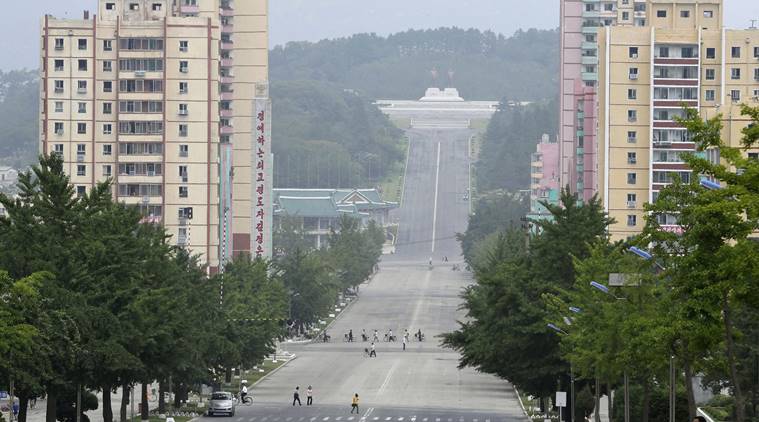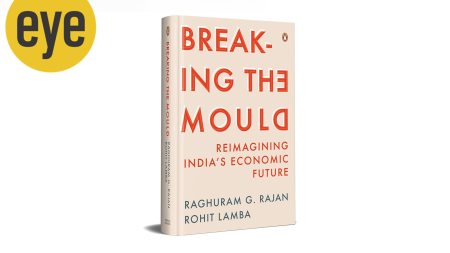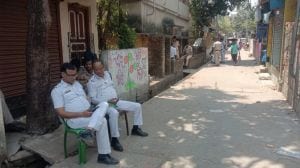- India
- International
North Korea thinks he brought Covid-19. The South wanted to arrest him
What happened to Kim after he crossed is unknown. North Korea said Sunday that he was in quarantine, accusing him of creating “the dangerous situation in Kaesong City that may lead to a deadly and destructive disaster.”
 People make their way in Kaesong, North Korea July 23, 2019. North Korean leader Kim Jong Un placed the city of Kaesong near the border with South Korea under total lockdown after a person was found there with suspected COVID-19 symptoms, saying “the vicious virus” may have entered the country, state media reported Sunday, July 26, 2020. (Naohiko Hatta/Kyodo News via AP)
People make their way in Kaesong, North Korea July 23, 2019. North Korean leader Kim Jong Un placed the city of Kaesong near the border with South Korea under total lockdown after a person was found there with suspected COVID-19 symptoms, saying “the vicious virus” may have entered the country, state media reported Sunday, July 26, 2020. (Naohiko Hatta/Kyodo News via AP)
Written by Choe Sang-Hun
Three years ago, out of work and hungry, Kim Geum Hyok climbed Mount White Horse near his North Korean hometown, Kaesong, brooding on the meaninglessness of life.
Not far to the south, across a river, the 21-year-old could see high-rise buildings in South Korea, dazzlingly lit up. The sight beckoned him.
After two nights on the mountain, Kim crossed the world’s most heavily armed border to get to it. He climbed down, crawled under and over layers of barbed-wire fences and made his way through minefields. At the river’s edge, he hid among reeds, improvising a life jacket from washed-up plastic trash. When night fell, he began to swim.
“I kept swimming toward the light,” Kim said of his 7 1/2 hours in the water, in an interview that a fellow North Korean defector posted on YouTube. “When I finally landed on the South Korean side and walked through reeds and saw South Korean soldiers approaching, I was so exhausted I collapsed.”

This month, after three years of life in the South, Kim went back — swimming across the same river he’d crossed in 2017, South Korean officials said. On Sunday, North Korea said he may have brought the coronavirus into the country for the first time, and it put Kaesong, Kim’s hometown, under lockdown.
On Monday, a police department in South Korea said that before Kim left, a warrant had been issued for his arrest on a rape accusation.
North Korea did not identify Kim in its statement. But South Korea said he was the only defector in the South who had gone back to the North this month. The South did not disclose his full name, but it released enough information for reporters to establish his identity.
And other defectors who knew him — including the YouTube interviewer, Kim Jin-ah, a woman from Kaesong — confirmed that it was him, uploading photos of Kim Geum Hyok to social media.
Weeks before his departure, Kim, now 24, gave several interviews for Kim Jin-ah’s YouTube channel, Lady From Kaesong, talking about his lives in the two Koreas. He used an alias and wore sunglasses, and in some clips his face had been digitally altered. Much of what he said could not be independently verified.
“I once visited his apartment in late June and I was surprised that it was so bare of furniture,” Kim Jin-ah said in a video posted after the man’s return to the North. “Looking back, I think he was already preparing to leave South Korea.”
Even before Kim Geum Hyok went back, his story was an unusual one. Most of the 33,000 North Korean defectors now living in South Korea got there by way of China and Southeast Asia. But some, like Kim, made the dangerous decision to cross the inter-Korean border.
For a defector to return, however — to a desolate economy and a dictatorship that calls defectors “human scum” — is rare. Eleven have done so in the past five years, according to the South’s Unification Ministry. Like many defectors, those who go back have often had trouble adjusting to the South’s freewheeling capitalist society.
In one of the YouTube interviews, Kim said he had lost most of his hearing at an early age.
“Because of that, I had difficulty communicating with people,” he said. “I was beaten because I was told to bring one thing and brought something else.”
When he was still a child, Kaesong, a city of 300,000, was chosen as the site of an industrial park run jointly by the two Koreas. It opened in 2004, and Kaesong became a boomtown, awash with cash. Kim’s cousins worked at the park, he said, and he himself sold eggs and vegetables.
But four years ago, the South shut down the complex in a dispute over the North’s nuclear weapons program. The economy crashed, and Kim, like many others, was soon out of work. (Last month, with inter-Korean relations at another low, the North blew up an office in Kaesong that it had jointly operated with the South.)
By the time he climbed Mount White Horse in June of 2017, Kim told Kim Jin-ah, he “saw no hope for the future, no meaning in life, wondering whether I should continue to live or die.” Seeing the South Korean buildings at night compelled him to “go there and check it out even if that meant my death,” he said.
Kim said he could not take his eyes off South Korean television during his debriefing by officials, which all defectors undergo after arriving in the South. In the North, all TV sets are preset to government propaganda channels.
Kim settled in Gimpo, a city across the Han River from Kaesong. A doctor corrected the hearing problem that he had lived with since childhood. He gave Kim Jin-ah no details about his condition or the treatment, but he told her that he cried that day.
He also told her that he missed his parents deeply. He had enrolled in a vocational school, as part of the resettlement program that the South offers to defectors. But he said he quit and found work, hoping to send money to his family, as defectors often do through middlemen in China.
Off camera, according to Kim Jin-ah, Kim confided something else.
He told her that he was being investigated by the police because another defector had accused him of raping her. He told the YouTube interviewer that he had been so drunk on the night in question that he couldn’t remember anything.
With Kim now in the North, it is impossible to contact him for comment. But the police in Gimpo confirmed that a warrant had been issued for his arrest.
Also read | Explained: Why the US envoy to South Korea has shaved off his moustache
On July 17, officials say, Kim arrived on Ganghwa Island, which may have been where he first set foot on South Korean soil. At 2:20 a.m. on the 18th, he got out of a taxi on the island’s northern shore. Around that time, he sent his last text message to Kim Jin-ah.
“I really didn’t want to lose you because you were like a big sister to me,” he wrote, according to Kim Jin-ah, who read the message on YouTube. “I will repay my debt to you no matter where I live, as long as I live.”
Kim Jin-ah, who was working at a 24-hour convenience store when the message arrived, rushed to Kim’s apartment as soon as her shift ended, she told her viewers.
She learned that he had given up the apartment days earlier, reclaiming his deposit. She said he had also sold a used car he had borrowed from her, apparently to raise as much money as he could before going home.
South Korean officials concluded that Kim had crossed by crawling through a drain, 3 feet in diameter, that runs underneath barbed-wire fences on Ganghwa’s north shore. That led him to the Han River, which they believe he swam back across.
In a bag near the drain, officials found bank receipts indicating that Kim had withdrawn 5 million South Korean won from his account, then converted most of that to $4,000.
What happened to Kim after he crossed is unknown. North Korea said Sunday that he was in quarantine, accusing him of creating “the dangerous situation in Kaesong City that may lead to a deadly and destructive disaster.”
Apr 28: Latest News
- 01
- 02
- 03
- 04
- 05








































